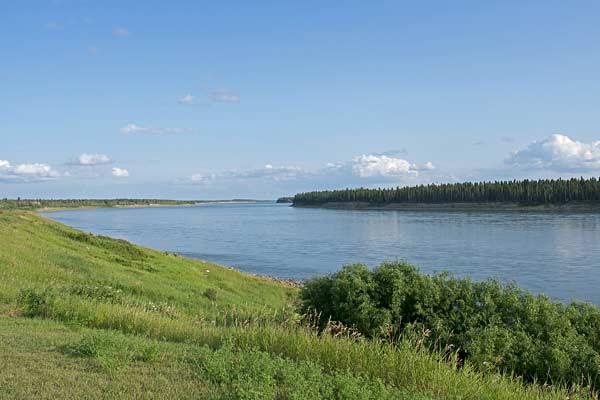Mackenzie; The Longest Rriver In Canada?
Canada’s rivers have played a vital role in the country’s history and cultural heritage. In Canada, rivers are called “rivers of the route” because they were used as trade routes for thousands of years.
Because rivers were therefore so important to the country’s population and economy, Canada has undertaken many efforts to conserve and protect Canadian waterways.
Mackenzie River
The longest river in Canada is the Mackenzie River, also the world’s second-longest river. Located in North America, it begins from near the Arctic Circle and flows westwards across the Canadian territory until reaching its mouth on Hudson Bay.
The Mackenzie River has a length of 4,241 kilometers. It is an extremely important river for transportation and industry in Canada because it connects many of the largest inland lakes to larger oceanic or coastal waterways such as Hudson Bay and Ungava Bay. The Mackenzie River also connects Canada’s northern and eastern regions.
The river has a fairly consistent flow throughout the year, although rainfall can affect the amount of water over the river’s sandy bottom. The average water level is about 1.38 meters during the summer months and about 15 m above sea level.
The Mackenzie River provides crucial transportation for the industry in the Mackenzie Valley region located in central Canada. Commercial fishing is an important economic activity along the river, with five southern regions of Canada dependent on it for their primary source of income.
Source of Mackenzie River
The river basin’s currents are mainly controlled by precipitation and meltwater from glaciers during the summer season. Tributary streams contribute about 80% of the total discharge during this season, while only 20% comes from water that flows from Canada toward the ocean.
The Mackenzie River begins as one stream but soon splits into two branches. It starts from these branches and travels westward through the Rocky Mountains until it reaches its mouth at the coast of the Arctic Ocean.
In Alberta, it is joined by the Peace River. The Mackenzie then flows north and west across the northwest corner of Yukon, reaching into the Northwest Territories before dividing into three distinct rivers. These are the Liard, the peace, and the Athabasca River.
They each flow separately into the Arctic Ocean at a point roughly 300 km north of Tuktoyaktuk in the territory of Nunavut.
The Mouth of Mackenzie River
The Mackenzie River begins as several small streams. It then becomes a river and flows westward for about 1,100 km before reaching its mouth on Hudson Bay.
The Mackenzie River mouth is at an elevation of 297 m, and the total length of this stretch is 440 km.
The Mackenzie River outlet has a water level that varies from day to day, but since the 1950s, it has been at 0.37 meters below sea level during the summer months and 0.73 meters during wintertime. Its average water level is around 1.38 meters.
Tributaries of The Mackenzie River
The Mackenzie River has two main tributaries, the Peace River and the Athabasca River. The first one is approximately 300 km to the north of its source and flows northward until it reaches the south boundary of the basin.
It continues to flow northward. It forms part of Canada’s border with Nunavut. In northern Alberta, it passes through Yukon territory and reaches Prince George at 2,300 meters above sea level.
Transportation In Mackenzie River
Transportation along the Mackenzie River is important to northern and central Canada. The river’s relatively consistent flow makes it an ideal means of transportation even during times of low water level.
Traveling by water is also the most environmentally friendly means of transportation on the river, especially when traveling from Alaska. The Mackenzie River’s size also helps to make it an effective means of transport.
Commercial fishing In Mackenzie River
Commercial fishing is a vital economic activity in the Mackenzie Valley region. The river is especially important to five southern Canadian regions located on the banks of the river and its tributaries.
Fishing in the Mackenzie River is a natural resource that Canada utilizes and all of its provinces and territories and several foreign countries.
International commercial fishing also occurs along the banks of other rivers in Canada, primarily in Alaska. Fishing contributes to Canada’s national economy, with the fish and wildlife resources playing a major role in Canada’s economy.
Both commercial fishing and transportation rely on the river’s entire length for their activity.
Mackenzie River As a Source of Fish and Wildlife
The Mackenzie River is also an important food source for people in Canada and Alaska. The fish and wildlife can be found in the river’s various tributaries, including the Peace River, a main tributary of the Mackenzie River itself.
The river basin also provides excellent conditions for several birds, including geese and ducks. In addition to these birds, it is an excellent source for many other fish and wildlife species.
Mackenzie River As a Source of Water
The Mackenzie River’s entire length is used as a water source for both transportation and industry. It is the largest river in Canada to be used as a water source, with only the Great Lakes being larger.
The water level of the Mackenzie River rises during summer and autumn, but winter sees it dropping to its lowest level, causing problems for residents. When the river drops to its lowest point, the ice thickens, preventing any form of transportation between the southern regions and northern Canada.
Conservation
The Mackenzie River is recognized as a national treasure, and it is one of the most important priority waterways in Canada.
In 2007, the Canadian government began a massive project to conserve the river by limiting commercial activities along its banks. Many other countries have also protected their rivers by implementing similar conservation efforts that limit business activities along rivers.
Canada has regulated industrial activity along the river since 1999 to decrease negative impacts on sensitive aquatic species.
Conclusion
All of these are favorable conditions and make the Mackenzie River grow yield fish annually.
The Mackenzie River system is one of Canada’s and North America’s largest rivers. It is three times as long as the second-longest river in Canada, and it has the fourth-largest drainage basin in North America, covering 1.8 million square km.







